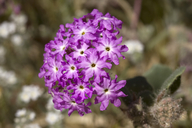Taxon Report
Abronia villosa Wats. var. aurita (Abrams) Jeps.chaparral sand-verbena |
 © 2011 Aaron E. Sims |
Taxon Summary
Abronia villosa var. aurita, commonly known as chaparral sand-verbena, is a annual herb in the Nyctaginaceae that is found in California and elsewhere. It occurs within Chaparral, Coastal scrub, and Desert dunes, growing at elevations from 75 to 1600 meters. Abronia villosa var. aurita is ranked 1B.1, Plants Rare, Threatened or Endangered in California and Elsewhere; Seriously threatened in California.Classification
|
Scientific Name: |
Abronia villosa Wats. var. aurita (Abrams) Jeps. |
|
Common Name: |
chaparral sand-verbena |
| Family: | Nyctaginaceae |
| Element Code: | PDNYC010P1 |
| USDA Plants Symbol: | ABVIA |
|
Synonyms/Other Names: |
|
Ecology and Life History
| Lifeform: | annual herb |
| Blooming Period: (Jan)Mar-Sep | (Jan)Mar-Sep |
| Elevation: | 75-1600 (245-5250) |
| General Habitats: | Chaparral, Coastal scrub, Desert dunes |
| Microhabitat: | Sandy |
| Microhabitat Details: |
Conservation Status
| CA Rare Plant Rank: | 1B.1 |
| Global Rank: | G5T2? |
|
State Rank: |
S2 |
| State List: | None |
| Fed List: | None |
| Other Status: | BLM_S; SB_CalBG/RSABG; USFS_S |
|
CRPR Changes: |
|
Occurrence Data from the CNDDB
| Total Occurrences: | 98 |
| Element Occurrence Ranks: | |
| Excellent (A) | 0 |
| Good (B) | 7 |
| Fair (C) | 9 |
| Poor (D) | 8 |
| None (X) | 7 |
| Unknown (U) | 67 |
| California Endemic: False | |
| California Counties and Islands: Name (Code) | |
| Imperial (IMP), Orange (ORA)*, Riverside (RIV), San Bernardino (SBD), San Diego (SDG) | |
| Quads: Name (Quad Code) | |
| Agua Caliente Springs (3211683), Aguanga (3311647), Alberhill (3311764), Anaheim (3311778)*, Anza (3311656), Bachelor Mtn. (3311751), Barstow (3411781), Beaumont (3311688), Black Star Canyon (3311776), Blackburn Canyon (3311667), Borrego Palm Canyon (3311634), Bucksnort Mtn. (3311645), Butterfly Peak (3311655), Cabazon (3311687), Calexico (3211564), Cathedral City (3311674), Collins Valley (3311644), Corona North (3311785), Corona South (3311775), Durmid (3311547), Earthquake Valley (3311614), East Deception Canyon (3311683), East of Victory Pass (3311573), Fallbrook (3311743), Heber (3211565), Hemet (3311668), Idyllwild (3311666), Indio (3311662), La Quinta (3311663), Lake Fulmor (3311677), Lake Mathews (3311774), Lakeview (3311771), Morro Hill (3311733), Mortmar (3311558), Murrieta (3311752), Myoma (3311673), Newport Beach (3311768)*, Orange (3311777)*, Palm Springs (3311675), Palm View Peak (3311665), Pechanga (3311741), Perris (3311772), Prado Dam (3311786), Ranchita (3311625), Sage (3311658), Salton (3311548), San Jacinto (3311678), Seeley (3211576), Temecula (3311742), Thermal Canyon (3311661), Tubb Canyon (3311624), Vail Lake (3311648), Valerie (3311652), White Water (3311686), Winchester (3311761) | |
Threat List Data from the CNDDB
| Threat List Total: | 16 | |
| EOs with Threat Listed: | Total EOs | % of EOs |
| 41 | 42 % | |
| Development | 17 | 17% |
| ORV activity | 13 | 13% |
| Altered flood/tidal/hydrologic regime | 8 | 8% |
| Biocides | 5 | 5% |
| Channelization | 5 | 5% |
| Road/trail construction/maint. | 5 | 5% |
| Vandalism/dumping/litter | 4 | 4% |
| Other | 4 | 4% |
| Non-native plant impacts | 4 | 4% |
| Agriculture | 3 | 3% |
| Recreational use (non-ORV) | 2 | 2% |
| Foot traffic/trampling | 2 | 2% |
| Grazing | 2 | 2% |
| Improper burning regime | 2 | 2% |
| Disking | 1 | 1% |
| Dam/Inundation | 1 | 1% |
Selected References
| Bulletin of the Torrey Botanical Club 32(10):537 (1905) |
Citation
California Native Plant Society, Rare Plant Program. 2026. Rare Plant Inventory (online edition, v9.5.1). Website https://www.rareplants.cnps.org [accessed 2 January 2026].